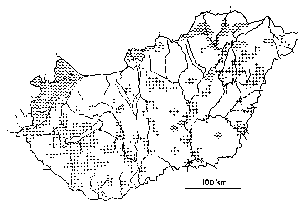 |
Last Update:
Friday November 23, 2018
|
| [Home] |
|
Volume 6 Pages 1 - 35 (February 1991) Citation: Kemenes, I. (1991). Otter Distribution, Status and Conservation Problems in Hungary IUCN Otter Spec. Group Bull. 6: 20-23 Otter Distribution, Status and Conservation Problems in Hungary Ildiko Kemenes Hungarian Natural History Museum, Baross u. 13, H-1088, Hungary.
The river otter Lutra lutra has been protected in Hungary since 1974 and became strictly protected in 1978. However, the first and so far only survey of its distribution was carried out by me in 1987-88. I now report the results of this survey and discuss the present status and conservation problems of otter in Hungary Methods The sampling method was the same as the one used for the British survey, described by Macdonald (1983). It was based on the 10 km square national grid, with 369 sites visited throughout Hungary. The sample points were scattered more or less evenly in places with suitable otter habitats. During the survey, data on the characteristics of different habitat types were also collected. Results The results of the survey are presented in Fig. 1. In areas shaded by + symbols signs of the presence of otter were found in each grid. In areas shaded by - symbols, no signs of otter were found in any of the grids, despite the presence of habitats judged to be suitable for otters. Areas with neither + nor - symbols were obviously unsuitable for otters (i.e. high hills and dry sand plains with no water, or the immediate environs of large cities). On the whole, I found signs of otters in 174 of the 201 grids visited (86 %). Of the total of 369 sites visited, I found signs of otter at 193 (52 %).
The species was found to be rare on the northern part of the country. The lowest number of positive sites was recorded from county Gyor-Sopron and country Zemplen. Two sides of the former are surrounded by the Austrian and Czechoslovakian borders, while the latter is situated near the Czechoslovakian and the Russian borders. On the Austrian side Lake Ferto, while along the Czechoslovakian border the River Danube could, in theory, provide suitable habitats but no signs of otters were found in either of them. The highest number of positive sites were recorded in the
south-west. Numerous small pond cultures and some larger
fish-farms can be found in this part of the country. The usually dense
vegetation around these ponds provides good cover for the otters, so even in ponds frequently
used by anglers, otters can survive. In the middle part of the country, on the great Hungarian plain
land, thriving populations can be found only around large fish farms. With the exception of the
surroundings of these ponds, the area is mostly dry. On the eastern part of Hungary otter signs
seem to be connected with the river Tisza and the most frequented sites were found at pond
cultures near Debrecen. The results of the survey show that the otter is still common in most parts of Hungary. However, with the exception of a few strongholds, the population density is low. There are some areas where despite the presence of suitable habitats no signs of otters were found. No exact data were available on the water quality in these areas, but it is clear that all these waters qualified as second class or worse, and the main pollutants found in them were oil, nitrite, and ammonium carbonate. Other factors in the habitat, such as human disturbance and type of bank vegetation appear to have only secondary influence on the distribution of otters, while availability of food seems to be the most important factor. In Hungary, like in Finland (Skarén 1990), the population density is highest around fish farms. Comparing my data with those from other surveys it seems that the situation of otters in Hungary is worse than in Ireland (Chapman & Chapman 1982) or in Scotland (Green & Green 1987), where otter signs were found at 92 % and 79 % of the visited sites, respectively. However, the proportion of positive sites was much higher than in England (6 %) (Lenton, Chanin & Jefferies 1980) or Wales (Crawford, Jones & McNulty 1979), or in most parts of central Europe (for a review see Mason & Macdonald 1986). According to the information on the situation of otters in Central and Eastern Europe, the Hungarian otter populations still represent the best strongholds of the species in the region.
Until the recent political changes, in Hungary, like in all eastern European countries, most of the fields have been cultivated by large agricultural cooperatives and only a small percentage of
animal husbandry was in private hands. Accordingly, the largest fish-farms were owned
by state organisations and most of the smaller ponds were cultivated by
anglers' associations. With the help of governmental subsidies these huge
farms and pond cultures could survive despite financial deficits. Without these subsidies lots of them will not be able to survive any longer. The destruction
of such fish-ponds will inevitably lead to the decline or even extinction of local otter REFERENCES Chapman, P.J. & Chapman, L.L.1982. Otter survey of Ireland 1980-81. Vincent Wildlife Trust |
| [Copyright © 2006 - 2050 IUCN/SSC OSG] | [Home] | [Contact Us] |
